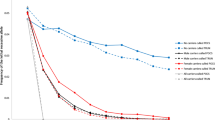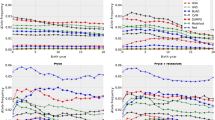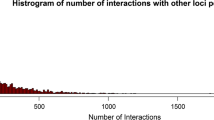Abstract
Random mutagenesis screens for recessive phenotypes require three generations of breeding, using either a backcross (BC) or intercross (IC) strategy. Hence, they are more costly and technically demanding than those for dominant phenotypes. Maximizing the return from these screens requires maximizing the number of mutations that are bred to homozyosity in the G3 generation. Using a probabilistic approach, we compare different designs of screens for recessive phenotypes and the impact each one has on the number of mutations that can be effectively screened. We address the issue of BC versus IC strategies and consider genome-wide, region-specific screens and suppressor screens. We find that optimally designed BC and IC screens allow the screening of, on average, similar numbers of mutations but that interpedigree variation is more pronounced when the IC strategy is employed. By conducting a retrospective analysis of published mutagenesis screens, we show that, depending on the strategy, a threefold difference in the numbers of mutations screened per animal used could be expected. This method allows researchers to contrast, for a range of experimental designs, the cost per mutation screened and to maximize the number of mutations that one can expect to screen in a given experiment.




Similar content being viewed by others
Notes
The formula used here is (average number of functional mutations per G1 pair) × (number of G1 pairs) × (average proportion of mutations screened per G1 pair). The final value in this product comes from Table 1 (efficiencies of mutation screens), where we convert from percentage to proportion by dividing by 100.
For brevity, we present only equations based on the less restrictive assumption that the number of pups born to each G2 female is flexible (while the number of pups born to each G2 male is fixed)
References
Augustin M, Sedlmeier R, Peters T, Huffstadt U, Kochmann E, et al. (2005) Efficient and fast targeted production of murine models based on ENU mutagenesis. Mamm Genome 16, 405–413
Beier DR (2000) Sequence-based analysis of mutagenized mice. Mamm Genome 11, 594–597
Bode VC, McDonald JD, Guenet JL, Simon D (1988) hph-1: a mouse mutant with hereditary hyperphenylalaninemia induced by ethylnitrosourea mutagenesis. Genetics 118, 299–305
Bogani D, Willoughby C, Davies J, Kaur K, Mirza G, et al. (2005) Dissecting the genetic complexity of human 6p deletion syndromes by using a region-specific, phenotype-driven mouse screen. Proc Natl Acad Sci USA 102, 12477–12482
Brockerhoff SE, Hurley JB, Janssen-Bienhold U, Neuhauss SC, Driever W, et al. (1995) A behavioral screen for isolating zebrafish mutants with visual system defects. Proc Natl Acad Sci USA 92, 10545–10549
Coghill EL, Hugill A, Parkinson N, Davison C, Glenister P, et al. (2002) A gene-driven approach to the identification of ENU mutants in the mouse. Nat Genet 30, 255–256
Concepcion D, Seburn KL, Wen G, Frankel WN, Hamilton BA (2004) Mutation rate and predicted phenotypic target sizes in ethylnitrosourea-treated mice. Genetics 168, 953–959
Cordes SP (2005) N-ethyl-N-nitrosourea mutagenesis: boarding the mouse mutant express. Microbiol Mol Biol Rev 69, 426–439
Driever W, Solnica-Krezel L, Schier AF, Neuhauss SC, Malicki J, et al. (1996) A genetic screen for mutations affecting embryogenesis in zebrafish. Development 123, 37–46
Haffter P, Granato M, Brand M, Mullins MC, Hammerschmidt M, et al. (1996) The identification of genes with unique and essential functions in the development of the zebrafish, Danio rerio. Development 123, 1–36
Haldane JBS (1919) The combination of linkage values and the calculation of distances between the loci of linked factors. Genetics 12, 101–109
Harding CO, Williams P, Pflanzer DM, Colwell RE, Lyne PW, et al. (1992) sar: a genetic mouse model for human sarcosinemia generated by ethylnitrosourea mutagenesis. Proc Natl Acad Sci USA 89, 2644–2648
Herron BJ, Lu W, Rao C, Liu S, Peters H, et al. (2002) Efficient generation and mapping of recessive developmental mutations using ENU mutagenesis. Nat Genet 30, 185–189
Hoebe K, Georgel P, Rutschmann S, Du X, Mudd S, et al. (2005) CD36 is a sensor of diacylglycerides. Nature 433, 523–527
Hrabe de Angelis MH, Flaswinkel H, Fuchs H, Rathkolb B, Soewarto D, et al. (2000) Genome-wide, large-scale production of mutant mice by ENU mutagenesis. Nat Genet 25, 444–447
Kasarskis A, Manova K, Anderson KV (1998) A phenotype-based screen for embryonic lethal mutations in the mouse. Proc Natl Acad Sci USA 95, 7485–7490
Kile BT, Hilton DJ (2005) The art and design of genetic screens: mouse. Nat Rev Genet 6, 557–567
Kile BT, Hentges KE, Clark AT, Nakamura H, Salinger AP, et al. (2003) Functional genetic analysis of mouse chromosome 11. Nature 425, 81–86
Miosge LA, Blasioli J, Blery M, Goodnow CC (2002) Analysis of an ethylnitrosourea-generated mouse mutation defines a cell intrinsic role of nuclear factor kappaB2 in regulating circulating B cell numbers. J Exp Med 196, 1113–1119
Mohr M, Klempt M, Rathkolb B, de Angelis MH, Wolf E, et al. (2004) Hypercholesterolemia in ENU-induced mouse mutants. J Lipid Res 45, 2132–2137
Pinto LH, Takahashi JS (2001) Functional identification of neural genes. In Methods in Genomic Neuroscience, Chin HR, Muldin SO, eds. (Boca Raton, FL: CRC Press)
Rinchik EM, Carpenter DA, Selby PB (1990) A strategy for fine-structure functional analysis of a 6- to 11-centimorgan region of mouse chromosome 7 by high-efficiency mutagenesis. Proc Natl Acad Sci USA 87, 896–900
Solnica-Krezel L, Schier AF, Driever W (1994) Efficient recovery of ENU-induced mutations from the zebrafish germline. Genetics 136, 1401–1420
Vinuesa CG, Goodnow CC (2004) Illuminating autoimmune regulators through controlled variation of the mouse genome sequence. Immunity 20, 669–679
Wilkie AO (1994) The molecular basis of genetic dominance. J Med Genet 31, 89–98
Williams RW, Flaherty L, Threadgill DW (2003) The math of making mutant mice. Genes Brain Behav 2, 191–200
Acknowledgments
Doug Hilton is an Australian National Health and Medical Research Council (NHMRC) Senior Principal Research Fellow. Benjamin Kile is an Australian Research Council (ARC) Queen Elizabeth II Fellow. Melanie Bahlo an NHMRC R. D. Wright Fellow. Jeremy Silver is a Bio21 Undergraduate Research Opportunities Program Scholar. The authors are particularly grateful to Vineeth Varughese for producing a web interface for EffiSim. They also thank Terry Speed for reviewing an early version of this work and Carolyn deGraaf for reviewing a later draft of this article; Gordon Smyth for various helpful suggestions; Peter Maltezos for producing Figures 1–3; and Tony Papenfuss, Jim Stankovich, and Keith Satterley for programming advice. Finally, five anonymous referees provided insightful and useful comments.
Author information
Authors and Affiliations
Corresponding author
Additional information
Melanie Bahlo and Benjamin T. Kile contributed equally to this work.
Appendix: Genome-wide efficiency derivations
Appendix: Genome-wide efficiency derivations
Probability of screening a given mutation
We begin by deriving the probability that no homozygotes (for a particular mutation) are born in a GPF. We fix the number of pups per G2 father, r, but not the number of pups per G2 female. We assume any pup could have come from any female with equal probability. This also includes the possibility that all pups came from the same female. To denote the genotype of mice at a mutation locus, let “m” and “+” represent the mutant and wild-type alleles (respectively). For the BC,
In the case of the IC, there can be several GPFs per G1 mating pair (h > 1). Hence,
Alternatively, we could fix the number of pups per G2 female, n, rather than the number of pups per G2 male. Then for the BC,
and for the IC,
Let us define P IC(h,θ) to be the probability of producing at least one G3 homozygote with the IC, where θ denotes parameters k and n or r (depending on whether we assume that the number of pups per G2 female is fixed or flexible, respectively). Similarly, define P BC(1,θ) for the BC. Note here that P IC(1,θ) = 0.5P BC(1,θ) under both sets of assumptions.
Mutation screen using the BC
Let X be the number of mutations in the region being screened that are carried by the G1 founder, and let E(X) = x. Assuming that mutations are segregating independently, then
,so
Mutation screen using the IC
Let X 1 and X 2 be the numbers of mutations carried by the two G1 founders (in the target region), both with mean x. If we again assume no linkage,
, then
Suppressor screen using the BC Footnote 2
Now consider screens for recessive suppressors of a recessive phenotype that use the BC. Let M sBC(1,X,d,1,k,r) be the number of mutations for which at least one G3 pup is homozygous, and homozygous for the sensitized allele. Results from the above derivations are applicable provided that we count only homozygous mutations in those G3 that are homozygous for the sensitized allele. Let Z j be the number of G3 pups in the jth GPF that are homozygous for the sensitized allele. Note that the Z j are independent and identically distributed. Then
So
If the sensitized allele is dominant rather than recessive, then we need to count homozygous mutations in those G3 that carry at least one copy of the sensitized allele. Then
So
Suppressor screen using the IC
Using a similar argument as above, we relate results from the BC to the IC.
Again, suppose that the sensitized allele is dominant, then
Rights and permissions
About this article
Cite this article
Silver, J.D., Hilton, D.J., Bahlo, M. et al. Probabilistic analysis of recessive mutagenesis screen strategies. Mamm Genome 18, 5–22 (2007). https://doi.org/10.1007/s00335-006-0057-z
Received:
Accepted:
Published:
Issue Date:
DOI: https://doi.org/10.1007/s00335-006-0057-z




